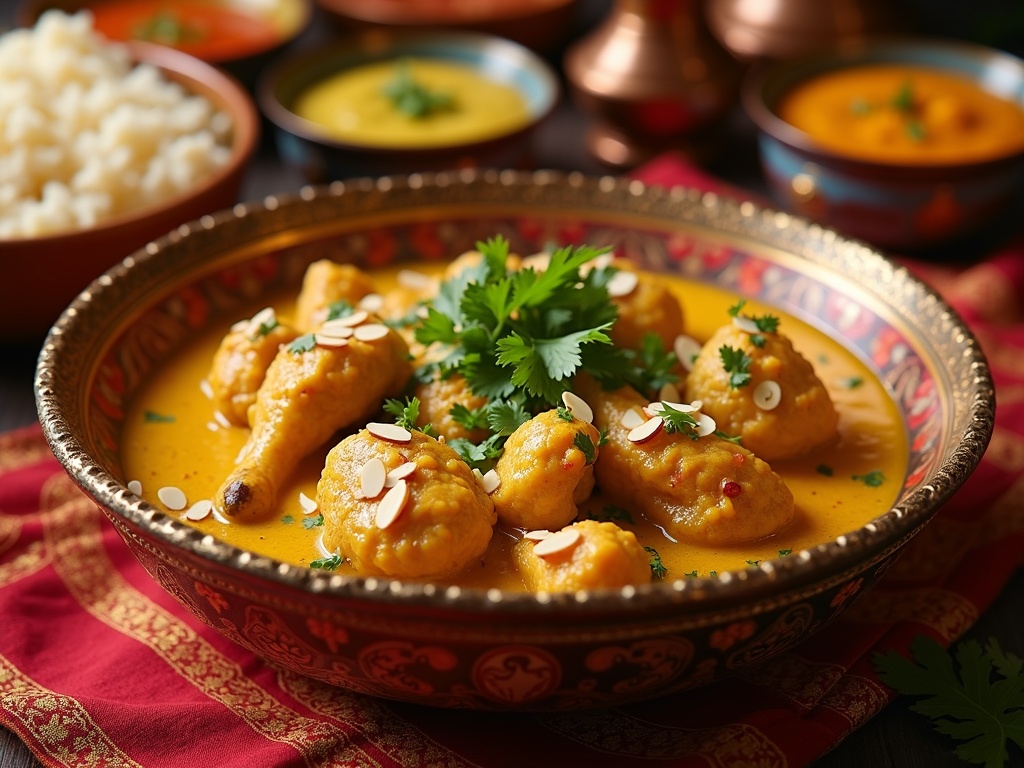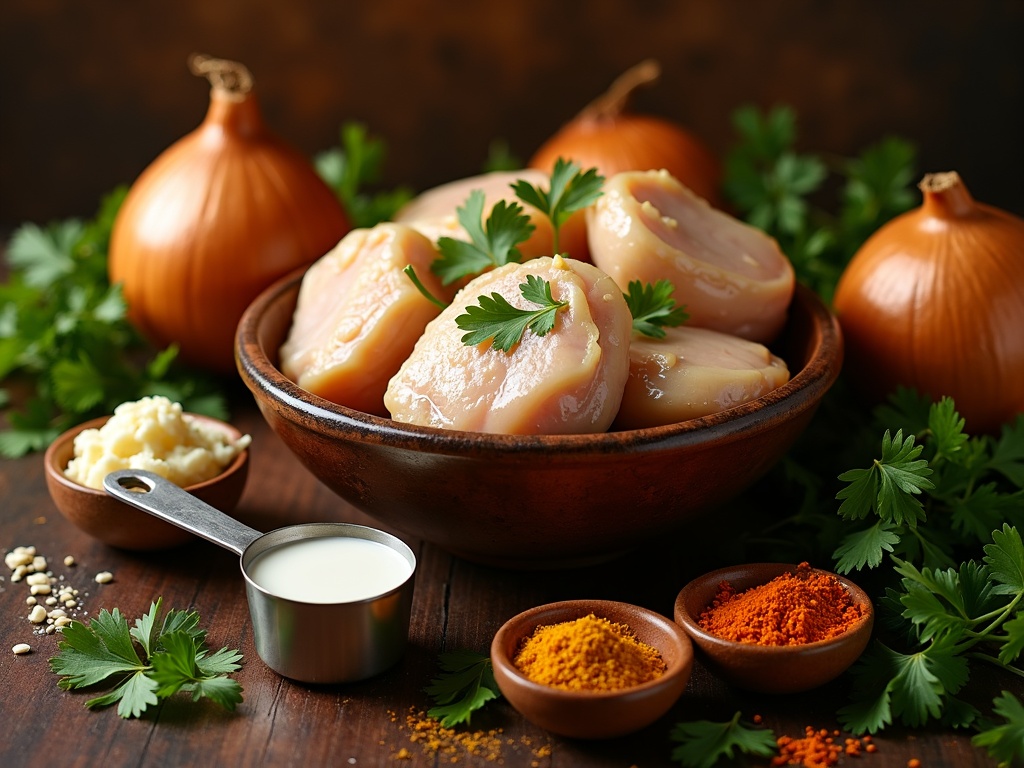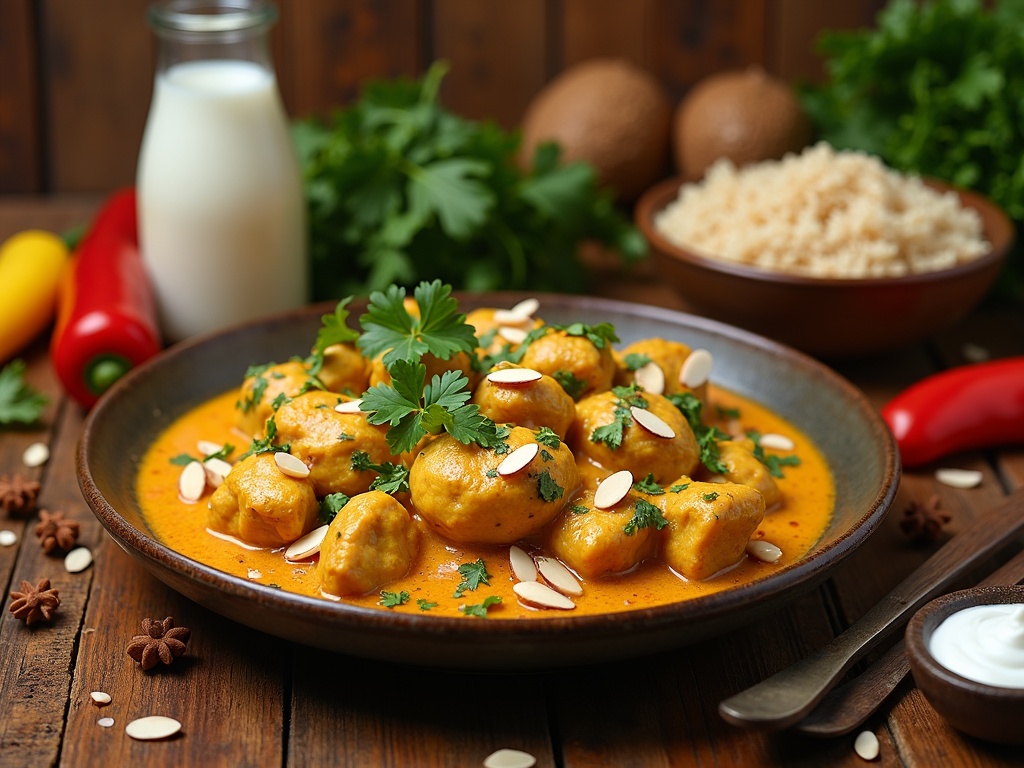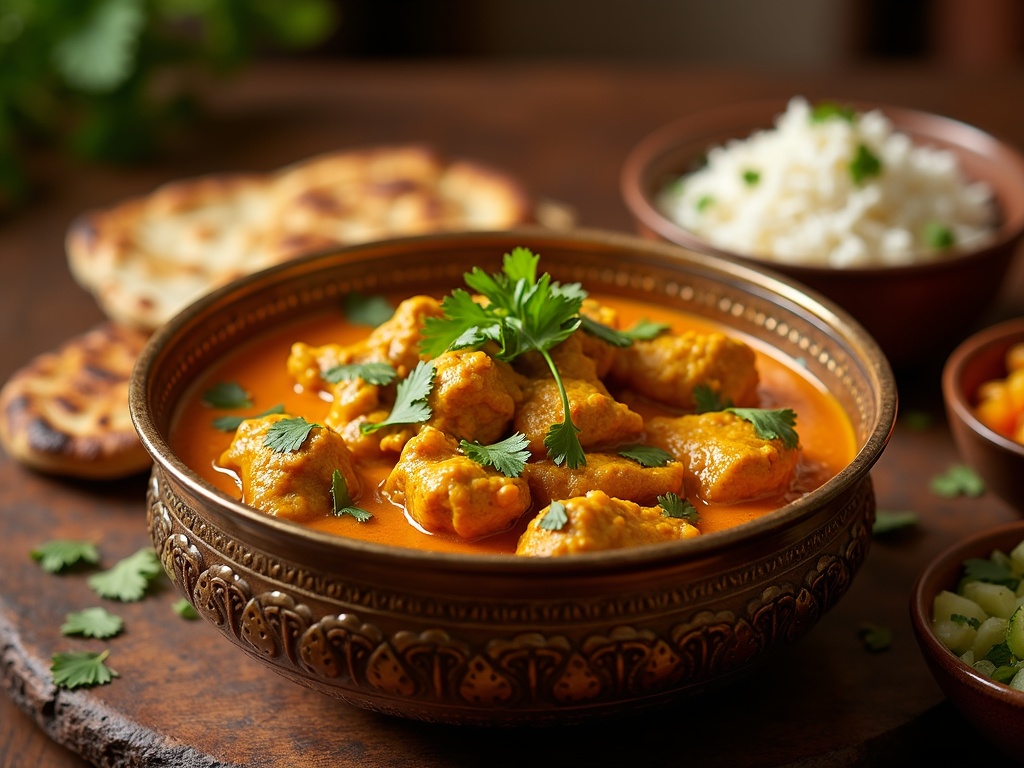Chicken korma recipe, a royal dish with Mughlai origins, combines tender chicken with a creamy, aromatic sauce that’s been refined through generations of South Asian culinary tradition. This celebrated recipe balances yogurt, ground nuts, and a rich spice blend to create a velvety curry that stands as a centerpiece at weddings, festivals, and special gatherings across the subcontinent.
Find In This Article
Key Takeaways
- Authentic chicken korma relies on key ingredients including chicken thighs (500g), yogurt (200g), cream (100ml), and a specific blend of ground spices including cumin, coriander, turmeric, and garam masala.
- Marinating the chicken in yogurt with spices for at least 30 minutes (or overnight) is crucial for developing flavor and tenderness.
- The caramelization of onions until golden brown (10-15 minutes) creates the essential flavor foundation for the entire dish.
- A standard 200g serving contains approximately 350 calories with 30g of protein and 25g of fat, making it a relatively balanced option.
- Traditional accompaniments like basmati rice, naan bread, cooling raita, and kachumber salad help create a complete, balanced meal experience.
The Secret to Perfect Chicken Korma
I’ve discovered that creating an authentic chicken korma isn’t just about following a recipe—it’s about understanding its rich heritage. This exquisite dish holds special significance in South Asian culinary traditions, particularly within Mughlai cuisine where it originated in the royal kitchens of India’s historical rulers.
Cultural Significance
Chicken korma stands as a symbol of hospitality and warmth in Indian culture. When guests arrive at homes across the subcontinent, serving korma communicates respect and honor. The dish’s presence at the dinner table immediately elevates any gathering into a special occasion.
The preparation of korma has been passed down through generations, with families guarding their secret techniques. While many modern kitchens now prepare simplified versions, the traditional slow-cooked chicken curry method yields unmatched depth of flavor.
Royal Origins and Festive Importance
Korma’s roots trace back to the lavish royal Mughlai cuisine, where it was crafted to impress nobility with its perfect balance of spices and rich, creamy texture. Court chefs would spend hours creating the perfect blend of aromatic spices, nuts, and cream to please their royal patrons.
Today, chicken korma remains an essential celebratory dish, making frequent appearances at:
- Wedding feasts, where it’s often the centerpiece dish
- Religious festivals and holidays
- Family milestone celebrations
- Special dinner parties where hosts want to impress guests
The preparation differs slightly from region to region. Some areas prefer a butter chicken recipe approach with more tomato, while others lean toward a nuttier base similar to lamb curry preparations.
What makes korma truly special is its versatility—the same cooking technique works beautifully with various proteins. I’ve found that while chicken is most popular, the korma preparation enhances everything from beef curry to vegetable curry variations.
The distinctive korma flavor comes from its unique spice blend and cooking method—meat first marinated in yogurt, then gently simmered in a sauce enriched with ground nuts, aromatic spices, and cream. This slow, gentle cooking breaks down the protein while allowing the flavors to meld perfectly, creating that signature korma taste that’s celebrated across continents.

Essential Ingredients for Authentic Flavor
Creating a perfect chicken korma requires ingredients that balance rich creaminess with subtle spice complexity. I’ve found that using the right components in proper proportions makes all the difference between an ordinary curry and a memorable one.
Core Components for Traditional Korma
The foundation of any authentic korma starts with selecting the right cut of chicken. I prefer using 500g of chicken thighs rather than breast meat because they remain tender and juicy throughout the cooking process. The natural fat content in thighs also contributes to the dish’s overall richness. For a different protein option, you might consider trying a lamb curry using similar techniques.
Plain yogurt (200g) serves multiple purposes in this recipe. It not only tenderizes the chicken when used as a marinade but also adds tanginess that balances the cream added later. Two large onions create the base flavor when properly sautéed until golden brown – this caramelization process releases natural sweetness that’s essential to korma’s character.
The aromatic foundation comes from 2 tablespoons of garlic and ginger paste, which infuses the dish with warmth and depth. I find this combination works beautifully in many curry variations, including a beef curry recipe if you’re looking to experiment.
For authentic flavor, include these ground spices:
- 1 teaspoon cumin for earthy notes
- 1 teaspoon coriander for citrus undertones
- 1 teaspoon turmeric for color and health benefits
- 1 teaspoon garam masala for complex warmth
Adding 100ml of cream near the end of cooking creates the signature velvety texture that distinguishes korma from other curries like butter chicken. Finally, fresh cilantro brightens the finished dish and adds visual appeal.
For a convenient weeknight option, many of these same ingredients can be adapted for a slow cooker chicken curry that develops flavor while you’re away. Vegetarians can enjoy similar flavor profiles by creating a vegetable curry with these same aromatic ingredients.

Master Chef’s Cooking Method
I start my chicken curry preparation with a crucial first step – marination. Mixing chunks of chicken with yogurt, salt, turmeric, and garam masala creates a base that tenderizes the meat while infusing it with flavor. For best results, I let this mixture sit for at least 30 minutes, though longer marination (up to overnight in the refrigerator) develops even deeper flavor notes.
The Cooking Process
When I’m ready to cook, I heat 2-3 tablespoons of ghee or oil in a heavy-bottomed pan over medium heat. The quality of the fat matters significantly here – ghee adds a nutty richness that elevates the dish compared to regular cooking oil.
Next comes the most patient part of making a good korma – sautéing onions until they reach a beautiful golden brown color, which takes about 10-15 minutes. This step creates the foundation of flavor for the entire dish. I stir occasionally to ensure even browning without burning.
Once the onions have caramelized, I add the aromatic spice blend followed immediately by the marinated chicken. I make sure to include all the marinade as it contains valuable flavor. The mixture initially bubbles vigorously as the yogurt reacts to the heat.
I then reduce the heat to medium-low, cover the pan, and let the chicken simmer for 25-30 minutes. During this time, I check occasionally and add between 200-300ml of water or chicken stock as needed to maintain a thick, gravy-like consistency. The liquid shouldn’t completely cover the chicken but provide enough moisture for gentle cooking.
For food safety, I always verify the chicken reaches an internal temperature of 75°C (165°F) using a meat thermometer. This ensures the chicken dish is perfectly cooked – tender and juicy without any risk.
The result is a rich, aromatic curry with melt-in-your-mouth chicken pieces surrounded by a velvety sauce that pairs perfectly with basmati rice or naan bread.
Perfect Pairings and Presentation
The right accompaniments can transform a delicious chicken korma recipe into an extraordinary dining experience. I’ve found that pairing this creamy, aromatic dish with the right sides creates a balanced meal that highlights the korma’s rich flavors.
Ideal Accompaniments
Fluffy basmati rice makes an excellent base for soaking up the korma’s luscious sauce. I prepare mine with a pinch of salt and a cardamom pod for subtle fragrance that complements without competing. Alternatively, warm naan bread offers a different but equally satisfying experience—tear off pieces to scoop up the sauce for a more interactive meal.
A cooling raita provides the perfect temperature and flavor contrast to the korma’s warmth. This simple yogurt-based side can be prepared in minutes by combining plain yogurt with grated cucumber, a pinch of cumin, and fresh mint. The creamy tanginess cuts through the richness of the korma, refreshing your palate between bites.
For a complete meal, I add these elements:
- A simple kachumber salad with diced cucumber, tomato, onion, and a squeeze of lemon juice
- A sprinkle of fresh cilantro over the korma just before serving
- A small dish of mango chutney for sweet-tart contrast
- Crispy pappadums as a textural element alongside the creamy curry
The traditional approach of serving multiple small accompaniments follows authentic Indian dining customs, where contrast and balance are key principles. This serving style also works beautifully for a dinner party, allowing guests to customize their plates.
For a more substantial meal, consider adding a vegetable curry as a side dish. The plant-based flavors provide a nice complement to the chicken korma’s richness.
When plating, I keep it simple by placing the korma in a shallow bowl with rice or bread to the side, allowing the golden color of the curry to stand out. A final sprinkle of cilantro adds both visual appeal and a fresh herbal note that brightens the entire dish.
Health and Nutrition Facts
The nutritional profile of chicken korma makes it a relatively balanced option when enjoyed as part of a varied diet. A standard 200g serving contains approximately 350 calories, providing substantial energy without being excessively high in calories compared to many other curry dishes.
Macronutrient Breakdown
Protein content is impressive at 30g per serving, largely thanks to the chicken that forms the base of this dish. This makes chicken korma an excellent option for those looking to maintain or build muscle mass. The fat content stands at 25g per serving, which comes primarily from the yogurt, cream, and nuts used in the traditional recipe. While this might seem high, these are mostly healthy fats that contribute to the dish’s satisfying nature.
Carbohydrate content is relatively low at just 12g per serving, with 5g coming from sugars. This makes chicken korma potentially suitable for those following lower-carb eating approaches, especially when compared to vegetable curry options that might include potatoes or other starchy vegetables.
Making Healthier Modifications
I can suggest several adjustments to enhance the nutritional profile of chicken korma:
- Use low-fat yogurt instead of full-fat options to reduce overall fat content
- Incorporate more vegetables like spinach or bell peppers to increase fiber and micronutrients
- Choose skinless chicken breast instead of thigh meat for leaner protein
- Reduce cream or replace with coconut milk for a different flavor profile
- Add extra almonds or cashews for healthy fats and additional protein
For a complete protein-packed meal, consider pairing your korma with brown rice or serving alongside a slow cooker chicken curry for variety. Alternatively, if you’re looking for different flavor profiles within the curry family, a rich butter chicken recipe offers another delicious option with a similar nutritional footprint.
The moderate calorie content makes chicken korma more diet-friendly than heavier options like beef curry or lamb curry, which typically contain higher fat content due to the nature of the meat used.

Sources:
Essential Indian Cookbook by Shubha Tiwari
The Complete Book of Indian Cooking by D. M. Sharma
Nutrition for the Culinary Practitioner by Scott Williams

